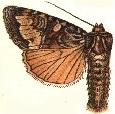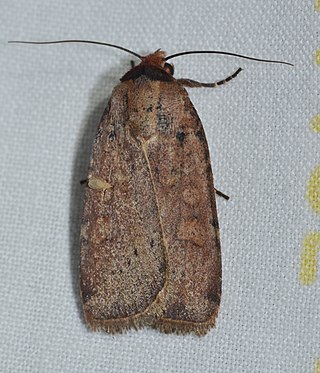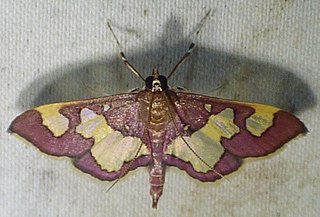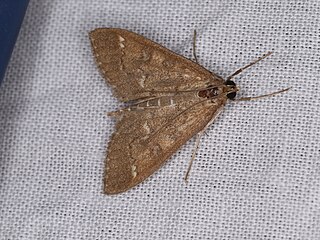
Mecyna is a genus of moths of the family Crambidae. The genus was first described by Henry Doubleday in 1849.

Catocala meskei, or Meske's underwing, is a moth of the family Erebidae. The species was first described by Augustus Radcliffe Grote in 1873. It is found in North America from Maine and Quebec west to southern Alberta and Montana, south to South Carolina in the east and at least Montana in the west.

Apamea occidens, the western apamea, is a moth of the family Noctuidae. The species was first described by Augustus Radcliffe Grote in 1878. It is native to western North America as far east as Alberta and Kansas.

Schinia nuchalis, the spotted sage moth, is a moth of the family Noctuidae. The species was first described by Augustus Radcliffe Grote in 1878. It is found from the Great Plains and Great Basin, from southern Saskatchewan, Alberta and British Columbia south to northern Arizona. The Eurasian Schinia scutosa is no longer considered a synonym of Schinia nuchalis.

Protolampra brunneicollis, the brown-collared dart, is a moth of the family Noctuidae. The species was first described by Augustus Radcliffe Grote in 1864. It is found in eastern North America from New Brunswick to Alberta in southern Canada, and in the United States from Maine to North Carolina and Tennessee west to Mississippi, north to Minnesota, with scattered records in the west from North Dakota, South Dakota and Montana.
Coenophila opacifrons, the blueberry dart or plain-faced blueberry dart, is a moth of the family Noctuidae. The species was first described by Augustus Radcliffe Grote in 1878. It is found in North America from Labrador and Newfoundland, south to New Jersey, west across the boreal forest to eastern British Columbia, south in the mountains to southern Montana.
Macrochilo bivittata, the two-striped snout-moth, is a litter moth of the family Erebidae. The species was first described by Augustus Radcliffe Grote in 1877. It is found from the Atlantic coast west across the parklands and southern boreal forest of North America to central Alberta, south to Massachusetts and Ohio.

Melitara dentata, the North American cactus moth, is a moth of the family Pyralidae. The species was first described by Augustus Radcliffe Grote in 1876. It is native to western North America, where it is widespread from Alberta to southern Arizona and central Texas. It is an introduced species in Hawaii.

Dioryctria abietivorella, the fir coneworm, is a species of snout moth in the genus Dioryctria. It was described by Augustus Radcliffe Grote in 1878, and is found in North America from southern Canada south to California in the west and North Carolina in the east.

Acrobasis tricolorella, the destructive prune worm or tricolored acrobasis moth, is a species of snout moth in the genus Acrobasis. It was described by Augustus Radcliffe Grote in 1878, and is known from southern Canada and northern United States.
Homoeosoma stypticellum is a species of snout moth in the genus Homoeosoma. It was described by Augustus Radcliffe Grote in 1878. It is found in North America, including Alberta, Illinois, Massachusetts, Minnesota, North Carolina, Oklahoma, South Carolina, Tennessee, Washington and West Virginia.

Apantesis nevadensis, the Nevada tiger moth, is a moth of the family Erebidae. It was described by Augustus Radcliffe Grote and Coleman Townsend Robinson in 1866. It is found in the Pacific Northwest of North America, as well as the inter mountain region and the Rocky Mountain states. In Canada, it is found in Alberta and southern Saskatchewan and Manitoba. The habitat consists of deserts, juniper woodlands and open sagebrush range-lands, as well as open forests.
Agriphila attenuata is a moth in the family Crambidae. It was described by Augustus Radcliffe Grote in 1880. It is found in North America, where it has been recorded from coastal California, Washington, Wyoming, British Columbia and Alberta. The habitat consists of grasslands.
Prorasea simalis is a moth in the family Crambidae. It was described by Augustus Radcliffe Grote in 1878. It is found in North America, where it has been recorded from Alberta, California, Colorado, Nevada and Oregon.
Loxostege anartalis is a moth in the family Crambidae. It was described by Augustus Radcliffe Grote in 1878. It is found in North America, where it has been recorded from coast to coast in Canada. In the west, the range extends south to California.

Pyrausta nicalis is a moth in the family Crambidae. It was described by Augustus Radcliffe Grote in 1878. It is found in North America, where it has been recorded from Quebec west to British Columbia, south to Colorado, Utah, Nevada and California.

Colomychus talis, the distinguished colymychus moth, is a moth in the family Crambidae. It was described by Augustus Radcliffe Grote in 1878. It is found in Mexico and the south-eastern United States, where it has been recorded from Alabama, Arkansas, Florida, Georgia, Maryland, North Carolina, Oklahoma, South Carolina and Virginia.

Mecyna mustelinalis is a moth in the family Crambidae. It was described by Packard in 1873. It is found in North America, where it has been recorded from Alberta, Arizona, British Columbia, California, Manitoba, Montana, Nevada, Saskatchewan, Utah, Washington and Yukon.
Mecyna submedialis, the orange-toned mecyna moth, is a moth in the family Crambidae. It was described by Augustus Radcliffe Grote in 1876. It is found in North America, where it has been recorded from Ontario and Michigan, south to Florida and west to Arkansas. It has also been recorded from Alberta.
Noctuini is a tribe of owlet moths in the family Noctuidae. There are at least 520 described species in Noctuini.








